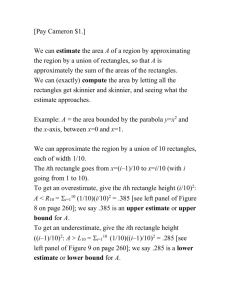ON A THEOREM OF W. MEYER-KÖNIG AND H. TIETZ
advertisement
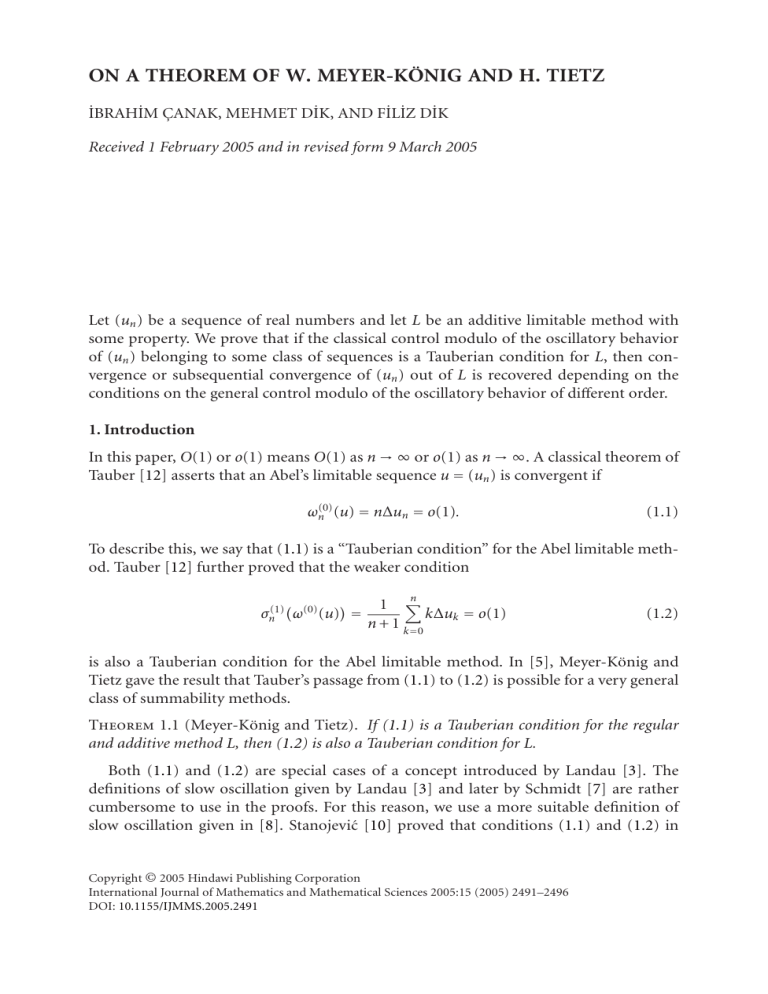
ON A THEOREM OF W. MEYER-KÖNIG AND H. TIETZ İBRAHİM ÇANAK, MEHMET DİK, AND FİLİZ DİK Received 1 February 2005 and in revised form 9 March 2005 Let (un ) be a sequence of real numbers and let L be an additive limitable method with some property. We prove that if the classical control modulo of the oscillatory behavior of (un ) belonging to some class of sequences is a Tauberian condition for L, then convergence or subsequential convergence of (un ) out of L is recovered depending on the conditions on the general control modulo of the oscillatory behavior of different order. 1. Introduction In this paper, O(1) or o(1) means O(1) as n → ∞ or o(1) as n → ∞. A classical theorem of Tauber [12] asserts that an Abel’s limitable sequence u = (un ) is convergent if ωn(0) (u) = n∆un = o(1). (1.1) To describe this, we say that (1.1) is a “Tauberian condition” for the Abel limitable method. Tauber [12] further proved that the weaker condition σn(1) ω(0) (u) = n 1 k∆uk = o(1) n + 1 k =0 (1.2) is also a Tauberian condition for the Abel limitable method. In [5], Meyer-König and Tietz gave the result that Tauber’s passage from (1.1) to (1.2) is possible for a very general class of summability methods. Theorem 1.1 (Meyer-König and Tietz). If (1.1) is a Tauberian condition for the regular and additive method L, then (1.2) is also a Tauberian condition for L. Both (1.1) and (1.2) are special cases of a concept introduced by Landau [3]. The definitions of slow oscillation given by Landau [3] and later by Schmidt [7] are rather cumbersome to use in the proofs. For this reason, we use a more suitable definition of slow oscillation given in [8]. Stanojević [10] proved that conditions (1.1) and (1.2) in Copyright © 2005 Hindawi Publishing Corporation International Journal of Mathematics and Mathematical Sciences 2005:15 (2005) 2491–2496 DOI: 10.1155/IJMMS.2005.2491 2492 On a theorem of W. Meyer-König and H. Tietz Tauber’s theorem [12] can be replaced by the more general conditions that ωn(0) (u) ∈ S, σn(1) ω (u) (0) (1.3) ∈ S, (1.4) where S denotes the class of all slowly oscillating sequences introduced in [8]. Stanojević’s passage from (1.3) to (1.4) is also possible for an additive method L, which need not to be regular, and satisfies some property. The main objective of this paper is to obtain convergence or subsequential convergence of (un ) by an additive method L with some property depending on the conditions on the general control modulo of the oscillatory behavior of different order if the classical control modulo of the oscillatory behavior of (un ) belonging to some class of sequences is a Tauberian condition for L. 2. Notations and definitions Throughout this paper, u = (un ) is a sequence of real numbers and λn denotes the integer part of λn. Denote by ωn(0) (u) = n∆un the classical control modulo of the oscillatory behavior of (un ). For each integer m ≥ 1 and for all positive integers n, define recursively ωn(m) (u) = ωn(m−1) (u) − σn(1) (ω(m−1) (u)) general control modulo of the oscillatory behavior of order m. For a sequence u = (un ) and for some integer m ≥ 0, denote 1 n σn(m) (u) = n + 1 k=0 un σk(m−1) (u) = u0 + n Vk(m−1) (∆u) k =1 k for m ≥ 1, (2.1) for m = 0, where 1 n V (m−1) (∆u) n + 1 k =0 k n Vn(m) (∆u) = 1 k∆uk n+1 k =0 un − un−1 ∆un = u0 for m ≥ 1, for m = 0, (2.2) for n ≥ 1, for n = 0, and σn(m) (u) − σn(m+1) (u) = Vn(m) (∆u). The Kronecker identity un − σn(1) (u) = Vn(0) (∆u) (2.3) is well known and will be used extensively. A sequence (un ) is Abel limitable to s if (1) n limx→1− (1 − x) ∞ n=0 un x = s and Cesàro limitable to s if limn σn (u) = s. If (un ) is L limitable to s, we write L − limn un = s. A limitation method L is called additive if L − limn un = s and L − limn vn = t imply that L − limn (un + vn ) = s + t. A sequence (un ) is İbrahim Çanak et al. 2493 slowly oscillating [8] if limλ→1+ limn maxn+1≤k≤λn | kj=n+1 ∆u j | = 0. Note that every null sequence is slowly oscillating. Since σn(1) (u) = u0 + nk=1 (Vk(0) (∆u)/k), from identity (2.3), we write (un ) as un = Vn(0) (∆u) + n Vk(0) (∆u) k =1 k + u0 . (2.4) It is shown in [11] that if (un ) is slowly oscillating, then (Vn(0) (∆u)) is bounded. Therefore, the slow oscillation of (un ) may be redefined in terms of its generating sequence (Vn(0) (∆u)). By (2.4), it is clear that a sequence (un ) is slowly oscillating if and only if (Vn(0) (∆u)) is bounded and slowly oscillating [2]. A sequence (un ) converges subsequentially [1, 9] if there exists a finite interval I(u) such that all of the accumulation points of (un ) are in I(u) and every point of I(u) is an accumulation point of I(u). Notice that there are slowly oscillating sequences that do not converge subsequentially. For instance, the sequence (logn) is clearly slowly oscillating, but not subsequentially convergent. 3. Lemmas We need the following lemmas to prove the theorems in the next section. Lemma 3.1 [9]. Let (un ) be Cesàro limitable to s. If (un ) is slowly oscillating, then (un ) converges to s. Proof. For λ > 1, we have un − σn(1) (u) = λ k n λn + 1 (1) 1 σλn (u) − σn(1) (u) − ∆u j . λn − n λn − n k=n+1 j =n+1 (3.1) From this identity, we have lim un − σn(1) (u) ≤ n λ λ−1 (u) − σn(1) (u) + lim max lim σλ(1) n n n n+1≤k≤λn k j =n+1 ∆u j . (3.2) Noticing that the first term on the right-hand side of (3.2) vanishes, we get limn |un − σn(1) (u)| ≤ limn maxn+1≤k≤λn | kj=n+1 ∆u j |. Finally letting λ → 1+ , we obtain limn |un − σn(1) (u)| ≤ 0. This completes the proof. Lemma 3.2 [1]. Let (un ) be a bounded sequence. If ∆un = o(1), then every point of [limn un , limn un ] is an accumulation point of (un ). Proof. Let limn un = l, and limn un = K. If l = K, there is nothing to prove. Assume that (l,K) is not a singleton, and that x ∈ (l,K) is not an accumulation point of (un ). Then, there exist distinct numbers b and c such that l < b < x < c < K and there exists a positive integer n1 such that for all n ≥ n1 , in [b,c] there is no point of (un ). From the assumption ∆un = o(1), it follows that there is a positive integer n2 such that for all n ≥ n2 , |un − un−1 | < c − b. Since l and K are two distinct accumulation points, there is 2494 On a theorem of W. Meyer-König and H. Tietz a positive integer m > max(n1 ,n2 ) such that, um < b. Hence for some n > m, un < b because there is no point of (un ) in [b,c]. Then, un+1 ≤ un + |un+1 − un | < b + c − b = c. / [b,c]. So un+1 < b. By finite induction on n, for all n > m, un < b. Thus, un+1 < c but un+1 ∈ Hence, limn un = K ≤ b < c < K, which is a contradiction. Consequently, every point of [limn un ,limn un ] is an accumulation point of (un ). 4. Tauberian conditions for convergence Throughout this paper, L will denote an additive limitation method with the following property: L − limn un = s implies that L − limn σn(1) (u) = s. Theorem 4.1. If (ωn(0) (u)) ∈ S is a Tauberian condition for L, then (σn(1) (ω(0) (u))) ∈ S is also a Tauberian condition for L. Proof. Assume that (ωn(0) (u)) ∈ S is a Tauberian condition for L. Let the L − limn un = s. For all nonnegative integers n, σn(1) (ω(0) (u)) = n∆σn(1) (u). Since L − limn un = s implies that L − limn σn(1) (u) = s and since (σn(1) (ω(0) (u))) ∈ S, we conclude that limn σn(1) (u) = s. Using identity (2.3), it then follows that (un ) ∈ S. Hence from Lemma 3.1, limn un = s. Theorem 4.2. If (ωn(0) (u)) ∈ S is a Tauberian condition for L, then (ωn(1) (u)) ∈ S is also a Tauberian condition for L. Proof. Assume that (ωn(0) (u)) ∈ S is a Tauberian condition for L. Let L − limn un = s. For all nonnegative integers n, ωn(1) (u) = n∆Vn(0) (∆u). By identity (2.3) and the additivity of L, we have L − limn Vn(0) (∆u) = 0. Together with (ωn(1) (u)) ∈ S, we obtain that Vn(0) (∆u) = o(1). Since (n∆σn(1) (u)) = (Vn(0) (∆u)) ∈ S and L − limn σn(1) (u) = s, it follows that (un ) is Cesàro limitable to L − limn un = s. By identity (2.3), we have limn un = s. Notice that in Theorem 4.2, the condition (ωn(1) (u)) ∈ S can be replaced by (ωn(k) (u)) ∈ S for any integer k ≥ 1. Since every null sequence is slowly oscillating, in the above theorems the condition “belonging to S” can be replaced by the condition “belonging to the class of all null sequences.” Hence, in particular, as an example of Theorem 4.1, we have the Meyer-König and Tietz theorem. Theorem 4.3. If (ωn(0) (u)) ∈ S is a Tauberian condition for L, then ωn(1) (u) = O(1) is also a Tauberian condition for L. Proof. Assume that (ωn(0) (u)) ∈ S is a Tauberian condition for L. Let L − limn un = s. Since n∆Vn(0) (∆u) = O(1), we have (Vn(0) (∆u) − Vn(1) (∆u)) = (n∆Vn(1) (∆u)) ∈ S. Since L − limn Vn(1) (∆u) = 0, it follows that Vn(1) (∆u) = o(1). By Lemma 3.1, we obtain Vn(0) (∆u) = o(1). From the identity n∆σn(1) (u) = Vn(0) (∆u), and L − limn σn(1) (u) = s, it follows that limn σn(1) (u) = s. Hence from (2.3), we have limn un = s. The following theorems are proved in a similar manner. Theorem 4.4. If ωn(0) (u) = O(1) is a Tauberian condition for L, then ωn(1) (u) = O(1) is also a Tauberian condition for L. İbrahim Çanak et al. 2495 Theorem 4.5. The following statements are equivalent. (i) ωn(0) (u) = O(1) is a Tauberian condition for L. (ii) (ωn(0) (u)) ∈ S is a Tauberian condition for L. 5. Tauberian conditions for subsequential convergence Littlewood [4] proved that ωn(0) (u) = O(1) (5.1) is a Tauberian condition for Abel limitable method. However, Rényi [6] noticed that σn(1) ω(0) (u) = O(1) (5.2) is not a Tauberian condition for Abel limitable method. We only recover convergence of the (C,1)-mean of the sequence (un ) out of the Abel limitability of (un ) and (5.2). Tauber’s passage from (5.1) to (5.2) is also not possible for an additive limitation method L. Nevertheless, we can retrieve some information about the subsequential behavior of the sequence (un ) by assuming an additional mild condition on (un ) with condition (5.2). In the next theorem, we show that σn(1) (ω(0) (u)) = O(1) together with an additional condition on (un ) yields subsequential convergence of (un ) out of L-limitability of (un ) if ωn(0) (u) = O(1) is a Tauberian condition for L. Theorem 5.1. If ωn(0) (u) = O(1) is a Tauberian condition for L, then the conditions σn(1) (ω(0) (u)) = O(1) and (∆Vn(0) (∆u)) ∈ S are Tauberian conditions for subsequential convergence of (un ) for L. Proof. Assume that ωn(0) (u) = O(1) is a Tauberian condition for L. Let L − limn un = s. Since n∆σn(1) (u) = O(1) and L − limn σn(1) (u) = s, it follows that limn σn(1) (u) = s. Since Vn(0) (∆u) = O(1), from identity (2.3), (un ) is bounded. From σn(1) (u) = nk=1 (Vk(0) (∆u)/k), it follows that Vn(0) (∆u)/n = o(1). Since (∆Vn(0) (∆u)) ∈ S, again by Lemma 3.1, ∆Vn(0) (∆u) = o(1). By the identity ∆un − (Vn(0) (∆u)/n) = ∆Vn(0) (∆u), we obtain ∆un = o(1). Therefore by Lemma 3.2, (un ) converges subsequentially. We end this section with the following result. Theorem 5.2. If (ωn(0) (u)) ∈ S is a Tauberian condition for L, then the conditions σn(1) (ω(0) (u)) = O(1) and (∆Vn(0) (∆u)) ∈ S are Tauberian conditions for the subsequential convergence of (un ) for L. Proof. Assume that (ωn(0) (u)) ∈ S is a Tauberian condition for L. Let L − limn un = s. The boundedness of (σn(1) (ω(0) (u))) implies that (Vn(1) (∆u)) ∈ S. Since n∆σn(2) (u) = Vn(1) (∆u) and L − limn σn(2) (u) = s, by hypotheses, we get limn σn(2) (u) = s. Since Vn(0) (∆u) = O(1), (σn(1) (u)) ∈ S. By Lemma 3.1, limn σn(1) (u) = s. By identity (2.3), (un ) is bounded. The rest of the proof is as the proof in Theorem 5.1. 2496 On a theorem of W. Meyer-König and H. Tietz References [1] [2] [3] [4] [5] [6] [7] [8] [9] [10] [11] [12] F. Dik, Tauberian theorems for convergence and subsequential convergence of sequences with controlled oscillatory behavior, Doctoral Dissertation, University of Missouri-Rolla, Missouri, 2002. M. Dik, Tauberian theorems for sequences with moderately oscillatory control moduli, Doctoral Dissertation, University of Missouri-Rolla, Missouri, 2002. E. Landau, Über die Bedeutung einiger neuen Grenzwertsätze der Herren Hardy und Axer, Prace Mat. Fiz. 21 (1910), 97–177. J. E. Littlewood, The converse of Abel’s theorem on power series, Proc. London Math. Soc. 9 (1911), 434–448. W. Meyer-König and H. Tietz, On Tauberian conditions of type o, Bull. Amer. Math. Soc. 73 (1967), 926–927. A. Rényi, On a Tauberian theorem of O. Szász, Acta Univ. Szeged. Sect. Sci. Math. 11 (1946), 119–123. R. Schmidt, Über divergente Folgen und lineare Mittelbildungen, Math. Z. 22 (1925), 89–152 (German). Č. V. Stanojević, Analysis of divergence: control and management of divergent process, Graduate Research Seminar Lecture Notes (İ. Çanak, ed.), University of Missouri-Rolla, Missouri, 1998. , Analysis of divergence: applications to Tauberian theory, Graduate Research Seminars, University of Missouri-Rolla, Missouri, 1999. Č. V. Stanojević, İ. Çanak, and V. B. Stanojević, Tauberian theorems for generalized abelian summability methods, Analysis of Divergence. Control and Management of Divergent Processes. Proceeding of the 7th International Workshop in Analysis and Its Applications, (Orono, ME, 1997) (W. O. Bray and Č. V. Stanojević, eds.), Appl. Numer. Harmon. Anal., Birkhäuser Boston, Massachusetts, 1999, pp. 13–26. O. Szász, Introduction to the theory of divergent series, Department of Mathematics, Graduate School of Arts and Sciences, University of Cincinnati, Ohio, 1944, lectures by O. Szász, written by J. Barlaz. A. Tauber, Ein Satz aus der Theorie der Unendlichen Reihen, Monatsh. f. Math. u. Phys. 8 (1897), 273–277 (German). İbrahim Çanak: Department of Mathematics, Faculty of Arts and Sciences, Adnan Menderes University, 09010 Aydin, Turkey E-mail address: icanak@adu.edu.tr Mehmet Dik: Department of Mathematics, Rockford College, 5050 E. State Street, Rockford, IL 61108, USA E-mail address: mdik@rockford.edu Filiz Dik: Department of Mathematics and Computer Science, Edgewood College, 1000 Edgewood College Drive, Madison, WI 53711, USA E-mail address: fdik@edgewood.edu

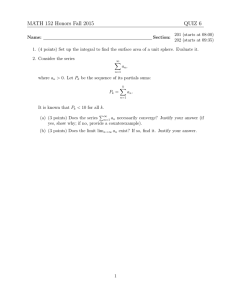
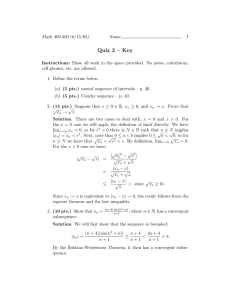
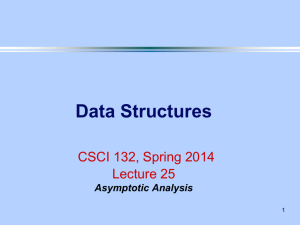

![MA342A (Harmonic Analysis 1) Tutorial sheet 7 [December 3, 2015] Name: Solutions P](http://s2.studylib.net/store/data/010415900_1-424cbb890b4ae55972a7e929b2daadc6-300x300.png)

